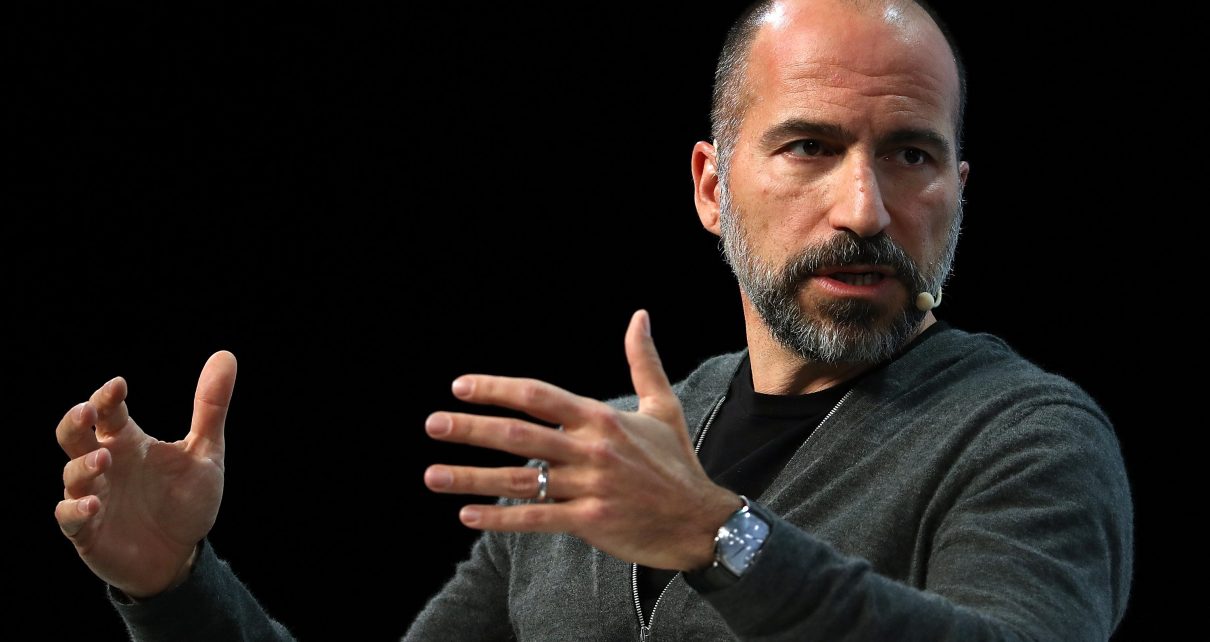Uber Technologies Inc. yesterday pledged to use only electric vehicles by 2030 in the United States, Canada and Europe, and by 2040 in the rest of the world.
The splashy climate announcement aligned Uber with rival Lyft Inc., which vowed to reach 100% EVs by 2030 in late June (Climatewire, June 22).
It raised questions, however, about the feasibility of both companies’ commitments, according to experts who study clean transportation.
On a Zoom call with reporters yesterday, Uber CEO Dara Khosrowshahi framed the goal as a response to the coronavirus pandemic.
“During the first lockdown,” Khosrowshahi said, “we saw a glimpse of the positive impacts of the record low emissions as a result of less transportation: blue skies replacing smog among city skylines, wildlife returning and pollution levels falling. Clogged roadways transforming into spaces for walking and cycling.”
He continued: “But it won’t last. Emission levels are already heading back to pre-COVID highs as recovery from the pandemic continues. … And at Uber, we’ve been thinking about what we can do. We want to take this moment as an opportunity to do more, to do better, and to do our part to drive a green recovery in our cities.”
In a blog post on Uber’s website, Khosrowshahi explained that the commitment includes four prongs.
The first is based on expanding Uber Green, a service that allows riders to choose drivers in hybrid and electric vehicles. The service will launch in 15 cities in the United States and Canada, including Chicago; San Francisco; Los Angeles; Seattle; Toronto; and Vancouver, British Columbia.
The second prong consists of investing $800 million in resources to help hundreds of thousands of drivers transition to EVs by 2025. Drivers who switch to fully electric cars will earn an additional $1.50 per trip, while drivers who switch to hybrids will earn an extra 50 cents per trip.
In addition, General Motors Co. will offer Uber drivers its employee discount on the new 2020 Chevrolet Bolt and charging accessories, GM said in a news release yesterday.
“The GM Employee Discount value for the average driver on the Uber platform can range from $2,500-$2,900 below [Manufacturer’s Suggested Retail Price] depending on how they choose their vehicle,” GM spokeswoman Maureen Bender wrote in an email to E&E News.
The third prong involves promoting alternatives to cars, including public transit, biking and walking. A new feature called “Uber and Transit” will allow passengers to plan trips that connect to bus and train stations.
David Reich, head of transit at Uber, demonstrated on Zoom how the new feature would work by using his hometown of Chicago as an example.
“We remain fully invested in expanding car-free options globally,” Reich said while illustrating that a short Uber trip to Wrigley Field—home of the Chicago Cubs—would be half as expensive when paired with transit.
The final prong involves “being transparent and accountable to the public along the way,” Khosrowshahi wrote in his blog post.
To that end, the company yesterday published a “Climate Assessment and Performance Report” on the carbon intensity of its rides from 2017 to 2019. The report showed that ridership grew 36% over that period, while carbon intensity fell 6%.
But total emissions still increased dramatically, as a reporter on the call was quick to point out.
‘One piece of the puzzle’
The reaction among auto analysts and environmentalists was mixed. Some praised Uber for reducing its contribution to climate change, while others doubted the company would make good on its promise without increasing incentives for drivers.
Sam Abuelsamid, principal analyst for e-mobility at the consulting firm Guidehouse Insights, fell into the latter camp.
He noted that the average price of a new Chevy Bolt is $36,620. Even with the employee discount, it would still cost around $33,720. That’s more expensive than popular gas-powered cars like the Nissan Altima ($24,100) or the Hyundai Sonata ($23,600).
In addition, Uber drivers are considered independent contractors rather than employees, so they don’t receive health insurance or paid time off. Both Uber and Lyft have vigorously lobbied against state and federal efforts to change that.
“With the drivers not being employees, it’s going to be a challenge for Uber to get them to move over to EVs in the near term,” Abuelsamid said. “I think ultimately, if they want to hit their targets, they’re going to have to increase those driver incentives even more than where they are today.”
Gina Coplon-Newfield, director of the Sierra Club’s Clean Transportation for All campaign, offered a more positive assessment.
The Sierra Club was one of several environmental groups that met with Uber to advocate for electrification, along with the World Resources Institute and Transport & Environment. Coplon-Newfield credited the pressure campaign with nudging the company toward its commitment.
“Sierra Club supporters over the past year and a half have really been pushing Uber and Lyft to make commitments like electrifying their vehicles and complementing public transit instead of competing with it,” she said.
Another green group, the Union of Concerned Scientists, turned up the pressure when it published an analysis in February that found ride-hailing services emit nearly 70% more climate pollution than the trips they replace, including those that involve biking, walking, public transit and private vehicles.
Don Anair, deputy director of the Clean Vehicles Program at the Union of Concerned Scientists and a lead author of the analysis, cheered Uber’s commitments while cautioning that they represent “just one piece of the puzzle.” The other pieces, he said, are policies and regulations that support the adoption of EVs and the build-out of car charging infrastructure.
One such regulation is taking shape in California, where the state Air Resources Board and Public Utilities Commission are drafting the Clean Miles Standard. It would require ride-hailing companies to develop emissions reduction plans and increase their reliance on EVs.
As California regulators continue drafting the rule over the next few months, Anair said, Uber should “support the level of stringency of these standards that would be consistent with what they’re saying publicly.”
Reprinted from Climatewire with permission from E&E News. E&E provides daily coverage of essential energy and environmental news at www.eenews.net.




